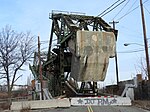Goethals Bridge

The Goethals Bridge () is the name of a pair of cable-stayed bridge spans connecting Elizabeth, New Jersey, to Staten Island, New York, in the United States. The spans cross a strait known as Arthur Kill, and replaced a cantilever bridge span built in 1928. The bridge is operated by the Port Authority of New York and New Jersey. The original cantilever span was one of the first structures built by the Port Authority. The New Jersey side is about 2.5 miles (4.0 km) south of Newark Liberty International Airport. The bridge was grandfathered into Interstate 278, and named for Major General George Washington Goethals, who supervised construction of the Panama Canal and was the first consulting engineer of the Port Authority. In 2013, two new cable-stayed crossings, running parallel to the old cantilever bridge and replacing it, were approved. The new eastbound span opened on June 10, 2017, at which time the original span was closed. The old cantilever span was dismantled in January 2018 and the new westbound span opened on May 21, 2018.
Excerpt from the Wikipedia article Goethals Bridge (License: CC BY-SA 3.0, Authors, Images).Goethals Bridge
Staten Island Expressway, New York Staten Island
Geographical coordinates (GPS) Address External links Nearby Places Show on map
Geographical coordinates (GPS)
| Latitude | Longitude |
|---|---|
| N 40.636 ° | E -74.197 ° |
Address
Goethals Bridge
Staten Island Expressway
07206 New York, Staten Island
New York, United States
Open on Google Maps







